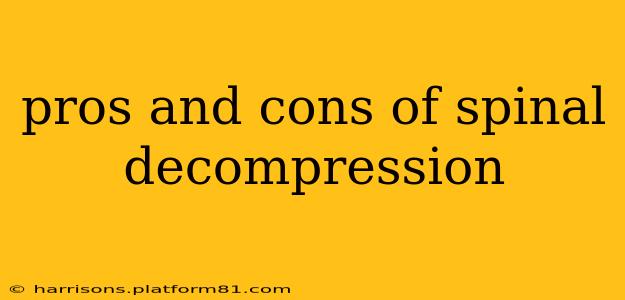Spinal decompression therapy is a non-surgical treatment option gaining popularity for managing various spinal conditions. It aims to alleviate pressure on the spinal nerves, often caused by herniated discs, degenerative disc disease, or spinal stenosis. However, like any medical procedure, it has its advantages and disadvantages. Understanding both is crucial before deciding if it's the right choice for you.
What is Spinal Decompression?
Spinal decompression therapy uses a specialized table or device to gently stretch the spine. This stretching creates negative pressure within the discs, allowing them to rehydrate and reduce pressure on the nerves. This can lead to pain relief and improved function. Different types of decompression exist, including traction and non-surgical spinal decompression using specialized tables.
Pros of Spinal Decompression
Improved Pain Relief: This is perhaps the most significant advantage. By reducing pressure on compressed nerves, spinal decompression can significantly alleviate back pain, neck pain, sciatica, and other related symptoms. Many patients report substantial pain reduction after a course of treatment.
Increased Disc Hydration: The stretching action helps draw fluid back into the intervertebral discs. This rehydration can improve disc height and elasticity, potentially slowing down the progression of degenerative disc disease.
Reduced Inflammation: The decompression process can help reduce inflammation around the spinal nerves, further contributing to pain relief and improved mobility.
Non-Invasive Procedure: Unlike surgery, spinal decompression is a non-invasive procedure. This means it avoids the risks and recovery time associated with major surgery.
Improved Mobility and Function: As pain reduces, patients often experience improved mobility, flexibility, and overall physical function. They may find it easier to perform daily activities without discomfort.
Minimally Invasive: Compared to surgery, the minimally invasive nature of decompression means less recovery time and reduced risk of complications like infection or nerve damage.
Alternative to Surgery: For many individuals, spinal decompression provides a viable alternative to surgery, allowing them to avoid the risks and recovery period associated with a surgical procedure.
Cons of Spinal Decompression
Not Suitable for All: Spinal decompression isn't suitable for everyone. Individuals with certain conditions, such as osteoporosis, spinal fractures, tumors, or uncontrolled infections, may not be good candidates. A thorough evaluation by a healthcare professional is essential.
Limited Success Rate: While many patients experience significant pain relief, the success rate of spinal decompression varies. The effectiveness depends on the individual's condition, the severity of the problem, and their overall health.
Potential Side Effects: Although generally safe, spinal decompression can cause mild side effects such as muscle soreness, fatigue, or temporary increases in pain. These side effects are usually temporary and resolve quickly.
Cost: Spinal decompression treatment can be expensive, and it may not be covered by all insurance plans. The cost will vary depending on the number of sessions required and the specific type of treatment.
Time Commitment: A course of treatment usually involves multiple sessions over several weeks, requiring a significant time commitment from the patient.
What are the risks of spinal decompression?
While generally considered safe, there are potential risks associated with spinal decompression, though they are relatively uncommon. These can include: muscle soreness, temporary increase in pain, headaches, and rarely, nerve irritation. A qualified healthcare professional should always assess individual risk factors before initiating treatment.
Is spinal decompression covered by insurance?
Insurance coverage for spinal decompression varies depending on the provider, the specific plan, and the diagnosis. It's essential to check with your insurance company to determine your coverage before starting treatment.
How long does it take to recover from spinal decompression?
Recovery time after spinal decompression is generally short. Most patients experience relief fairly quickly, with minimal downtime. However, the total recovery period can vary, and consistent engagement with prescribed home exercises might be beneficial.
What are the long-term effects of spinal decompression?
The long-term effects of spinal decompression can be quite positive for many patients. Continued pain relief, improved mobility, and improved quality of life are common long-term outcomes. However, it's crucial to remember that the success of the treatment will depend on the patient’s underlying condition and their response to the therapy.
Conclusion:
Spinal decompression can offer a significant benefit for individuals suffering from spinal pain and related conditions. However, it's crucial to weigh the pros and cons carefully and discuss the procedure with a healthcare professional to determine if it's the right approach for your specific situation. A comprehensive evaluation will help to ascertain the suitability of spinal decompression and to manage expectations regarding potential outcomes. Remember that this information is for educational purposes and should not be considered medical advice. Always consult with a doctor or other qualified healthcare professional for any questions you may have regarding a medical condition.
